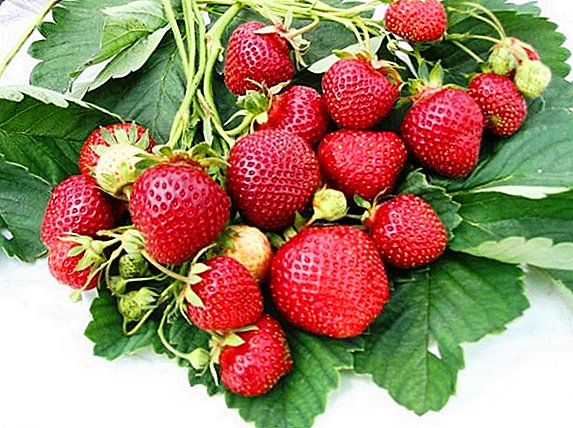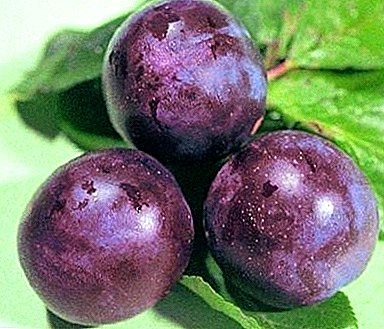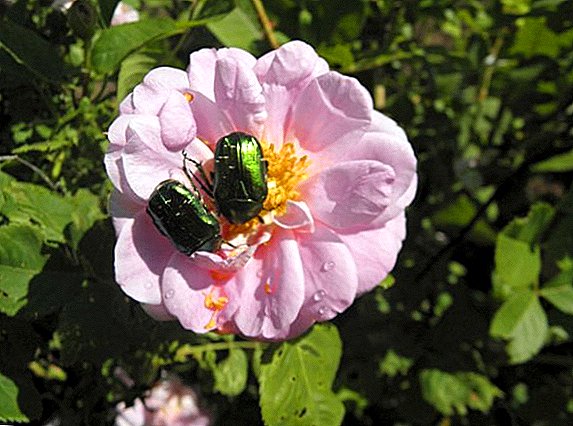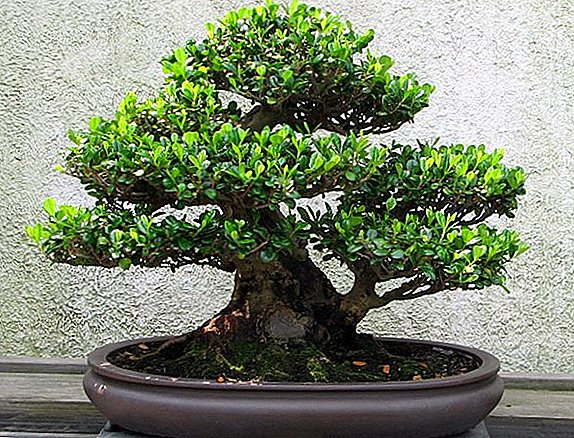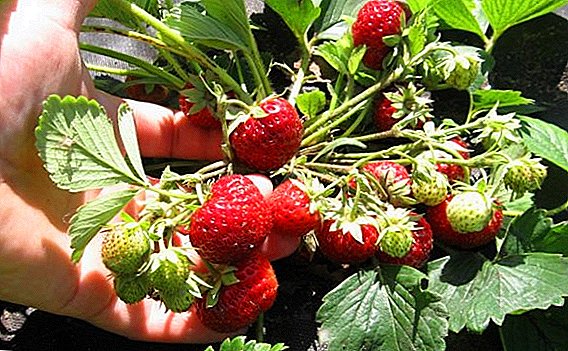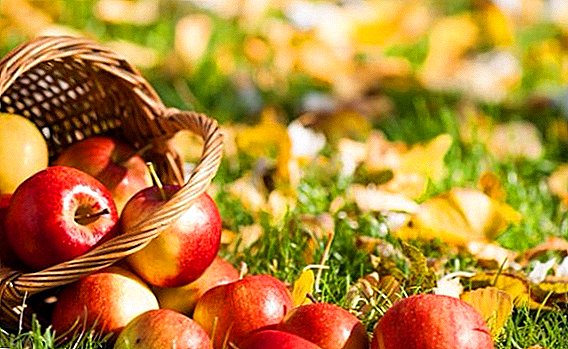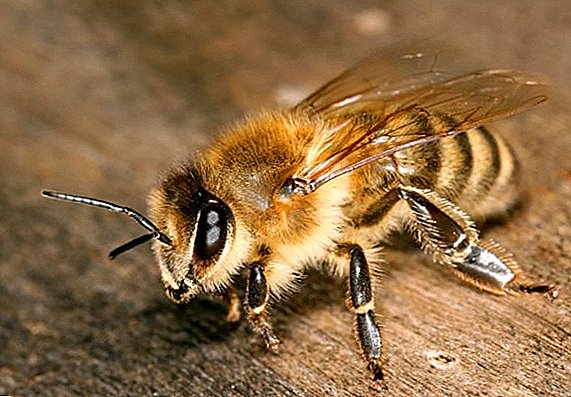 Honey, perhaps, is one of the most valuable gifts of nature, which mankind has long known and appreciated.
Honey, perhaps, is one of the most valuable gifts of nature, which mankind has long known and appreciated.
Beekeeping is an occupation that requires certain knowledge about honey bees (after all, not every bee can produce honey), organization of a bee family and conditions that are comfortable for their livelihoods.
Honey bee structure
The body of insects is conditionally divided into three main parts: the head, chest and abdomen.
On the head are antennae antennas, a pair of compound eyes and three simple eyes, an oral apparatus. Antennae are important organs of touch and help to navigate in space. The mouth or proboscis consists of several organs: the upper and lower jaws, the upper and lower lips.
Consider the chest section, how many wings have a bee. She has two pairs of membranous wings: lower and upper. The lower wings in the upper part have hooks, which during flight are connected with the upper pair of wings.
Read about what you need to know first of all a beginner beekeeper.
On the abdomen are three pairs of legs. The inside of the legs is equipped with brushes with which the worker cleans the pollen, defining it in baskets. Baskets are located on the hind legs. 
The insect has a hard outer shell (an analogue of the skin of a person), which protects internal organs from various damages or temperature drops and performs the function of the skeleton.
In addition to hard cover, the body is covered with many hairs.
Hair cover performs several important functions:
- protects the body from pollution;
- serves to transfer pollen;
- heats insects in winter (the bees are pressed tightly against each other, creating a kind of tangle).
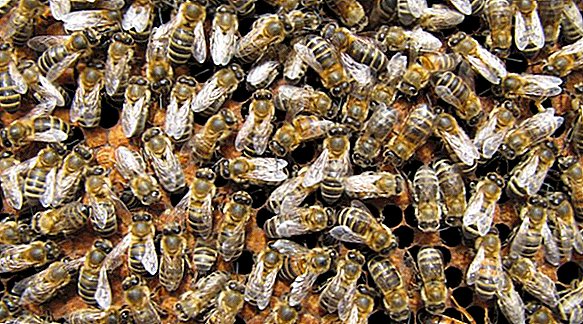
Did you know? The queen bee can be called a black widow, so after mating with her, the male dies, leaving his penis in the body of the uterus.
Features of internal organs and systems
It is hard to believe, but the structure of the internal organs of a honeybee almost completely repeats the human body: the respiratory, digestive, circulatory systems of bees are well developed, they have a heart, a brain, and a complex set of senses.
Digestion
The digestive system is divided into three sections:
- first department - mouth, pharynx, esophagus, honey goiter;
- second - stomach;
- third - intestines.
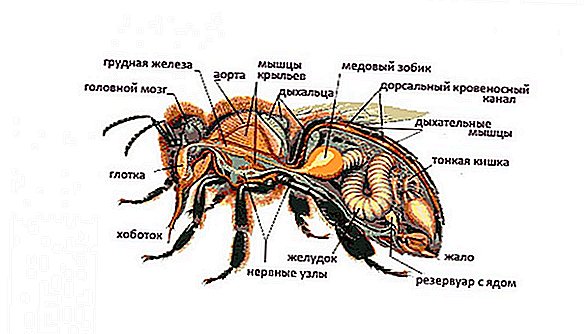
The pharynx is continued by the esophagus, which is located in the thoracic region; the esophagus, expanding, forms a goiter for honey storage. This organ in an empty form has a volume of 14 mm cubic, but with the help of muscles, being filled, it stretches three to four times. With the help of the same muscles through the esophagus and proboscis, the goiter pushes the contents out.
Next comes the stomach, in fact - this is the intestine, in which the processes of digestion take place.
Third department - the intestine is represented by two guts: thin and straight. The rectum contains undigested food residues, the harmful effects of which are eliminated by prolonged exposure through the release of certain opposing substances from the glands.
Breath
The insect has a powerful respiratory system that covers almost the entire body.
Breathe in through numerous openings in the body.: three pairs on the chest and six on the abdomen. In these spiracles, the air passes through the hairs, cleansing, enters the air bags connected to each other, and then oxygen is carried through the trachea throughout the body. Exhalation occurs through the third pair of spiracles located in the thoracic region.
Heartbeat
The five-chamber heart of the bee is like an elongated tube, the organ stretches from back to head through the entire upper part of the body, the aorta is located in the thoracic region.
Hemolymph is a colorless tissue fluid instead of blood in the insect, in fact, the plasma that performs the same function as human blood. The heart valves pass the hemolymph from the abdomen to the head, and the dorsal and thoracic diaphragms regulate its uniform current. Pulsation of the heart in a honeybee in a calm state - 60-70 beats per minute, immediately after the flight increases to 150 beats.
One of the most valuable products of beekeeping is honey, and it can be of various types, for example, such as acacia, acacia, coriander, buckwheat, lime, fatselium, rapeseed, white, and even wild.
Sense organs
A bee has five eyes that see 360 degrees around itself plus everything above and below. 
Each eye sees what is in front of him, and all together they see what they see in a single picture. Vision is called mosaic, as a pair of complex eyes consists of 4-10 thousand peepholes (depending on the caste membership). This vision allows you to see the direction of the light wave and determine the position of the sun, even in cloudy weather.
For the sense of smell and touch are the antennae located on the head and part of the hairs covering the body. The antennae also allow bees to determine the weather: temperature, humidity. Taste buds are located on the paws, antennae, proboscis and in the throat. The insect has no ears, but it has a hearing. The apertures are located in some parts of the body and legs.
Did you know? The honeycomb cell is a perfect geometric shape, hexagon with exact proportions and the same angles.
Life cycle features
Bee family is divided into three castes: womb, drones and workers. Life expectancy is different for everyone. How much a bee lives depends on the caste: the queen lives up to seven years, the drones last about five weeks, the workers live up to eight weeks.
At the end of winter, the uterus lays eggs, the larvae appear within three days. The larvae are fed by working bees for approximately six days. Then the larva with the help of wax is closed in the cell, where it pupates - turns into an adult insect. 
It takes about 12 days, and an imago appears - an individual that differs from a fully-grown and formed bee only in its softer skin. Its role is to feed the brood, "clean" the hive and perform other "household" duties.
In the hive reigns strict hierarchy. The role of the uterus is reduced to the brood and the replenishment of the bee family. It can leave the hive only during swarming.
Drones - males, are large, they have no sting. Their life task in the hive is fertilization of the womb. It is noteworthy that immediately after mating the drones die. A much larger number of drones are born in hives than is necessary for mating with the uterus, therefore those who did not participate in the mating process are simply expelled from the family.
Their life task in the hive is fertilization of the womb. It is noteworthy that immediately after mating the drones die. A much larger number of drones are born in hives than is necessary for mating with the uterus, therefore those who did not participate in the mating process are simply expelled from the family.
Workers are female individuals.. These specimens shoulder all the work "at home" and beyond. Young specimens are busy cleaning the hive and caring for the larvae, and experienced collect nectar, monitor the arrangement of the hive - weatherization, construction, provide protection to the family.
The most common breeds of honey plants
Honey plants are of different species, differing from each other in appearance and with some peculiarities in development and life activity.
Consider the most famous of them:
- European dark - the most common type. She has a large dark body and a short proboscis. The honey produced by the species is light in color. This species is a bit irritable, it seems aggressive. Among the positive qualities of the family are disease resistance, fertility, and weather resistance. One family in the season brings up to 30 kg of honey.

- Ukrainian steppe. Small in size, color more yellow, temperament smooth, not aggressive. Resistant to cold and disease. During the season, the family produces up to 40 kg of honey, which compares favorably with other breeds.
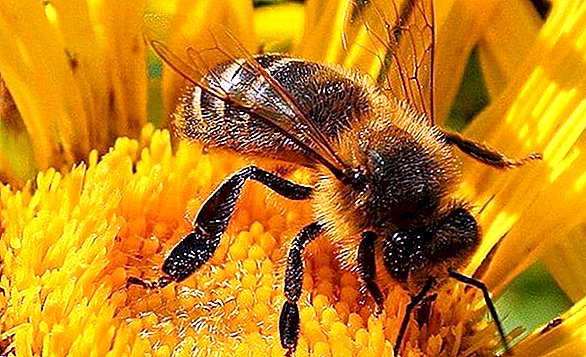
Check out the popular breeds of bees, and find out the differences between them.
- Caucasian The size is similar to the Ukrainian breed, the color of the body is gray with yellow. Differs in a long proboscis, able to reach nectar even from deep cups of flowers. Hardworking, even working in the fog, resistant to disease, but aggressive. Productivity of one family - up to 40 kg.
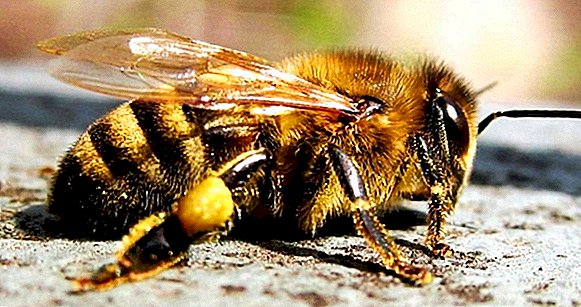
- Italian imported from the Apennines, has a long proboscis, yellow belly and pronounced rings along the whole body. It is calm and clean, it destroys the moth, spoiling in the hives, carefully cleans the hives, which has a positive effect on the products of its labor. It is able to overcome the disease, but productivity is much lower than that of other breeds.
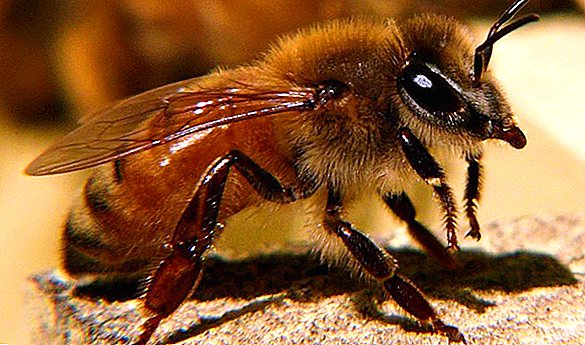
- Carpathian honey plant has a gray body, not aggressive, is popular with beekeepers. Abundant swarming, resistance to low temperatures, good productivity - up to 40 kg.
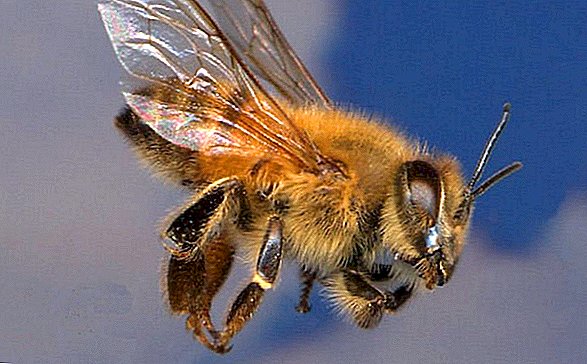
Basic content rules
Beekeeping requires at least minimal knowledge of the structure of bee colonies, their needs, starting from the location of the “home” and its arrangement.
A place
The apiary is placed on dry, sheltered from the wind areas, it is desirable to protect it by planting shrubs. On the site planted plants honey plants.
Important! It is impossible to equip an apiary close to roads and industrial facilities: in the first case a distance of at least five hundred meters, in the second - up to five kilometers.
Home improvement rules for bees
The hive houses are placed at a distance of three meters from each other, ten meters between rows. To recognize the bees of their homes they are painted in white, yellow or blue shades.
To protect against insect pests, the windows of the "houses" are closed with a fine-mesh grid. The apiary is necessarily equipped with drinkers, insects, too, are thirsty.
Growing rules
In the spring (April - May), before the resettlement, the bee houses are disinfected, the same applies to equipment and clothing in which the beekeeper works with the wards.
Settlement of families spend warm time with a temperature not lower than 10 ° C of heat, weakened families unite, their houses are warmed. Closer to the nectar collection season, bees are examined for possible diseases or insects in hives.
Learn how to make a beehive with your own hands.
In the summer, you need to replace the framework filled with honey with new ones in a timely manner, stimulating the wards for productivity.
In the fall, the swarm is prepared for wintering and fed. The diet is honey, perga or sugar syrup. To prepare the syrup, water and sugar take two to one. 
When cleaning hives, dead individuals are burned.
In a state of swarming, bees can be dangerous to animals and humans.
Swarming occurs for the following reasons:
- the venerable age of the uterus (4 years);
- if ventilation is broken in the nest, there is overheating;
- the uterus allocates special pheromones, at this time there are rubs (underdeveloped drones), it is caused by a disease or old age of the uterus.
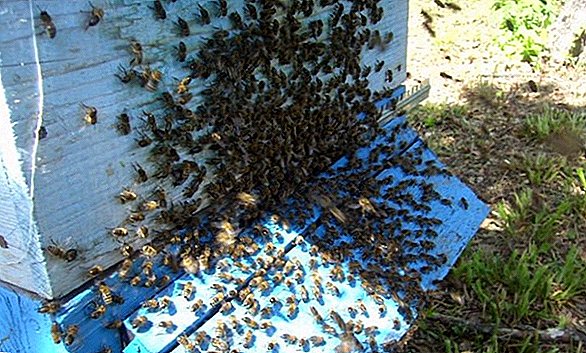
This process can be recognized in advance by the following features:
- workers begin active construction of queen cells;
- no departures swarm for nectar, because of this, the uterus weakens, because it is not fed;
- a weakened uterus does not lay eggs and significantly decreases in size and weight.
Important! To avoid swarming, the beekeeper should fix the situation on time (ten days before swarming). If the hives are in the sun, they need to be transferred to the shade. In the spring you need to plant a plot with honey plants tightly in order to distract the wards with work.
What are the homemade honey plants different from wild ones?
We will understand how to distinguish a honeybee, to recognize whether a domestic or wild individual is in front of you.
Wild individuals of slightly smaller size and less bright coloration.. They can not attract attention to themselves, because, unlike home copies, there is no one to protect them, so they are very aggressive.
Wild bees are more hardy, they cover a greater distance in search of nectar, produce more honey. Their bodies are more resistant to diseases and are able to survive frosts down to minus 50 ° C.
Wild swarms settle and organize beehives mainly in tree hollows or in rock crevices. Build their nests vertically, using wax as a "cement". Since there are no frames in their nests, the shape of the cells is lingual.
Bees are hardworking workers, they fly great distances to collect and deliver nectar to the hive. Attentive and careful attitude towards them will pay off with a good supply of useful product.









